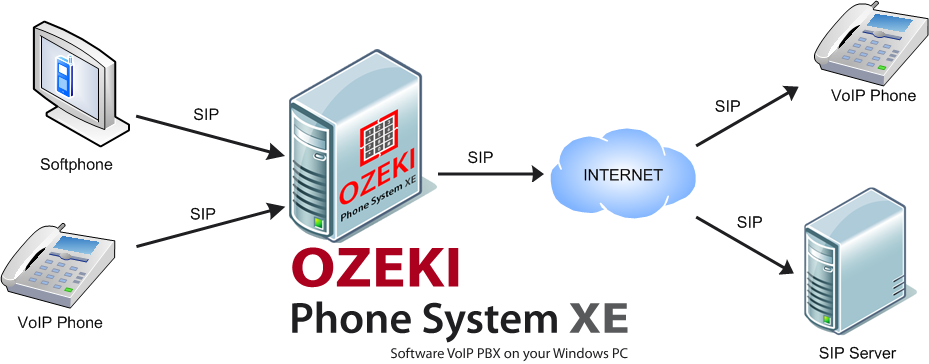What is SIP Server?
In this text you can find the terms connected to SIP servers and how to make a use of having an account in them. If you would like to build up/modernise your communication system, having a basic knowledge on SIP servers is a must. After reading this page, you will be familiar with the basics of SIP servers and you will get to know how to make use of them in your business' work.
As Figure 1 represents, the SIP clients (a VoIP Phone and a softphone on a computer) connect to the SIP server, the Ozeki Phone System PBX with a SIP connection. The SIP server is also connected with a SIP connection to the Internet: via the Internet, the SIP server can connect to all types of telecommunication systems (to another VoIP Phone and another server in this Figure) - what will make it possible to call anyone in the world who has a phone number or an IP address.

SIP and SIP Server
The Session Initiation Protocol (SIP) is designed to create communication channels between two or more participants through the Internet. SIP can manage real-time multimedia sessions, so real-time dials that are not necessarily phone calls but chat, audio and/or video calls and even instant messaging, audio and/or video conferences can be organised. SIP is the signaling protocol of VoIP, Voice over Internet Protocol.
The SIP server is the centre of an Internet-based communication system: the caller connects to the server (that is also known as PBX Private Branch eXchange or PABX, Private Automated Branch eXchange), and the server will forward the call to the proper destination. This whole process is done through the Internet what leads to maximum reliability and high quality.
How to Use a SIP Server?
In order to use a SIP server, you have nothing else to do but to create a SIP account: this can be done with a simple registration to the Ozeki Phone System. The process is as easy as creating an e-mail account: just give the user data and your SIP account is created.
If you need a SIP account, you may download the Ozeki Phone System software on your computer or phoning device, and after the installation and some configuration, your computer or device becomes a SIP client and your communication system is ready for using.
To get more information about SIP communication and VoIP technology, please take a look at our pages that may inform you in details:
More information
- What is VoIP (Voice over Internet Protocol)?
- What is SIP (Session Initiation Protocol)?
- What is PABX (Private Automated Branch Exchange)?
- What is IP PBX? (Internet Protocol Private Branch Exchange)
- What is VoIP PBX (Voice Over Internet Protocol Private Branch Exchange)?
- What is SIP Trunking (Session Initiation Protocol Trunking)?
- What is SIP Trunk (Session Initiation Protocol Trunk)?
- What is Direct Dial In: DID?
- What is IVR (Interactive Voice Response)?
- What is RTP (Real-time Transport Protocol)?
- What is RTCP (Real-time Transport Control Protocol)?
- What is SRTP?
- What is H323?
- What is VoIP Tunnel?
- What is PSTN Gateway?
- What is CAPI?
- What is FXO?
- What is FXS?
- What is PRI/E1?
- What is PRI/T1?
- What is PRI/J1?
- What is PRI?
- What is ISDN NT?
- What is ISDN TE?
- What is VoIP Client (Voice Over Internet Protocol Client)?
- What is SIP Client?
- What is SIP Server?
- What is VoIP Server (Voice Over Internet Protocol Server)?
- What is Dial Plan?
- What is Asterisk?
- What is VLAN?
- What is VoIP Phone?
- What is SIP Phone?
- What is IP Phone?
- What is SIP Account?
- What is ATA?
- What is Ring Group?
- What is Virtual PBX?
- What is Hosted PBX?
- What is PSTN?
- What is SDP (Session Description Protocol)?
- What is DECT?
- What is VoIP Call?
- What Is VoIP Cluster?
- What is Trunk?
- What is Fring?

 Sign in
Sign in